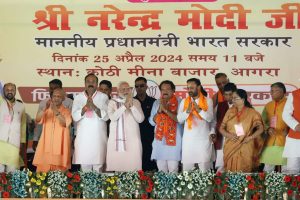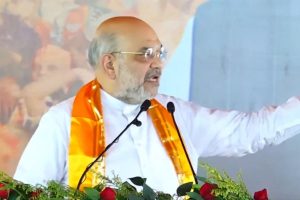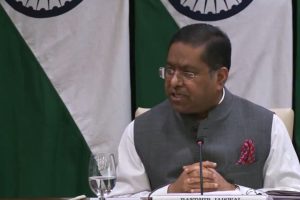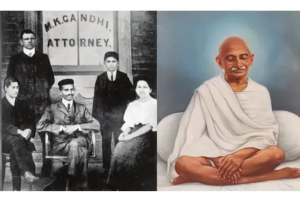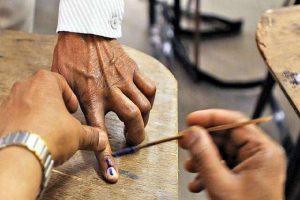There is a post doing the rounds in social media regarding a statue of the ancient Hindu law giver Manu in front of the Rajasthan High Court. There is a call for its removal on the ground that Manusmriti encouraged caste discrimination, advocates oppression of Dalits and was fiercely criticised by Dr. Ambedkar.
Questions have been raised by citizens as to whether installation of a statue of Manu in the premises of the Rajasthan High Court on government land amounts to State promoting a religion and if so whether it is permissible under the Constitution or Constitutional ethos, India being avowedly a secular democratic republic.
To address the issue, one needs to look at the relevant provisions of the Constitution of India starting with the Preamble in which the word secular was inserted through the controversial 42nd amendment in 1976. The substantive provisions are contained in Articles 25 to 30 of the Constitution.
Article 25 is the cornerstone in this regard, the material part of which reads as follows: “25. (1) Subject to public order, morality and health and to the other provisions of this Part, all persons are equally entitled to freedom of conscience and the right freely to profess, practise and propagate religion…”
For understanding what secularism means in the context of the Constitution, it is necessary to refer to the First Amendment to the Constitution of United States which reads as follows: “Congress shall make no law respecting an establishment of religion, or prohibiting the free exercise thereof; or abridging the freedom of speech, or of the press; or the right of the people peaceably to assemble, and to petition the Government for a redress of grievances.”
A comparison would reveal that there is a clear mandate in the First Amendment containing an interdict against the State establishing any religion. This part of the First Amendment is popularly referred to as the establishment clause. It is noteworthy that such an interdict against the State is conspicuously absent in the Indian Constitution. Before discussing the Indian scenario further, it is necessary to refer to judicial pronouncements of the federal Supreme Court of the United States.
For the sake of brevity, I will refer to only two, namely Trinity Lutheran Church of Columbia, Inc. Versus Comer, Director, Missouri Department of Natural Resources (2017) and American Legion et al Versus American Humanist Assn. et al (2019). These two judgments although decided by majority opinions, capture the current judicial view on the establishment clause which according to the liberal judges who dissented was introduced by Founding Father Thomas Jefferson to create a wall of separation between the State and the Church.
However, according to the majority judges it was Jefferson’s view alone and not a consensus of the Founders codified in the text of the Constitution. The initial tests of determining whether establishment clause in the First Amendment has been violated were laid down by the decision of the US Supreme Court in Lemon v. Kurtzman, (1971), and the analysis applied by Justice Breyer in upholding the Ten Commandments monument at issue in Van Orden v. Perry.
Under the Lemon test, a court must ask whether a challenged government action (1) has a secular purpose; (2) has a “principal or primary effect” that “neither advances nor inhibits religion”; and (3) does not foster “an excessive government entanglement with religion.” However, the Lemon Test has now been practically discarded by the majority judges in recent decisions.
In Trinity Lutheran Church, although the majority based their opinion on a competitive reading of the establishment clause and the freedom of exercise clause both contained in the First Amendment, and rested their opinion on the ground that invoking the establishment clause in the facts of the case would defeat the freedom of exercise clause, the minority viewed the majority opinion to be in the teeth of the establishment clause.
Justice Sotomayor in her minority view (which was joined in by Justice Ginsburg) observed as follows: “Today’s opinion suggests the Court has made the leap the Mitchell plurality could not. For if it agrees that the funding here will finance religious activities, then only a rule that considers that fact irrelevant could support a conclusion of constitutionality. The problems of the ‘secular and neutral’ approach have been aired before. See, e.g., id., at 900-902 (Souter, J., dissenting).
It has no basis in the history to which the Court has repeatedly turned to inform its understanding of the Establishment Clause. It permits direct subsidies for religious indoctrination, with all the attendant concerns that led to the Establishment Clause. And it favors certain religious groups, those with a belief system that allows them to compete for public dollars and those well-organized and well-funded enough to do so successfully.4 Such a break with precedent would mark a radical mistake.
The Establishment Clause protects both religion and government from the dangers that result when the two become entwined, ‘not by providing every religion with an equal opportunity (say, to secure state funding or to pray in the public schools), but by drawing fairly clear lines of separation between church and state – at least where the heartland of religious belief, such as primary religious [worship], is at issue.’
Zelman v. Simmons-Harris, 536 U.S. 639, 722-723 (2002) (Breyer, J., dissenting).” In American Humanist Association, the facts are that since 1925, the Bladensburg Peace Cross (Cross) has stood as a tribute to 49 area soldiers who gave their lives in the First World War. Eighty-nine years after the dedication of the Cross, respondents filed this lawsuit, claiming that they are offended by the sight of the memorial on public land and that its presence there and the expenditure of public funds to maintain it violate the Establishment Clause of the First Amendment.
To remedy this violation, they asked a federal court to order the relocation or demolition of the Cross or at least the removal of its arms. The Court of Appeals for the Fourth Circuit agreed that the memorial is unconstitutional and remanded for a determination of the proper remedy. The matter came before the federal Supreme Court. Reversing the judgment of the Court of Appeals, the majority in the Supreme Court held the memorial to be constitutional.
The main judgment was delivered by Justice Alito (Justices Ginsburg and Sotomayor dissenting) in which it was observed, inter alia, as follows: “While the Lemon Court ambitiously attempted to find a grand unified theory of the Establishment Clause, in later cases, we have taken a more modest approach that focuses on the particular issue at hand and looks to history for guidance. Our cases involving prayer before a legislative session are an example.
“In Marsh v. Chambers, 463 U.S. 783 (1983), the Court upheld the Nebraska Legislature’s practice of beginning each session with a prayer by an official chaplain, and in so holding, the Court conspicuously ignored Lemon and did not respond to Justice Brennan’s argument in dissent that the legislature’s practice could not satisfy the Lemon test. Id., at 797–801. Instead, the Court found it highly persuasive that Congress for more than 200 years had opened its sessions with a prayer and that many state legislatures had followed suit. Id., at 787–788. We took a similar approach more recently in Town of Greece, 572 U.S., at 577.
“We reached these results even though it was clear, as stressed by the Marsh dissent, that prayer is by definition religious. See Marsh, supra, at 797–798 (opinion of Brennan, J.). As the Court put it in Town of Greece: ‘Marshmust not be understood as permitting a practice that would amount to a constitutional violation if not for its historical foundation.’ 572 U.S., at 576.
The case teaches instead that the Establishment Clause must be interpreted ‘by reference to historical practices and under-standings’ and that the decision of the First Congress to ‘provid[e] for the appointment of chaplains only days after approving language for the First Amendment demonstrates that the Framers considered legislative prayer a benign acknowledgment of religion’s role in society’.”
The prevalence of this philosophy at the time of the founding is reflected in other prominent actions taken by the First Congress. It requested – and President Washington proclaimed – a national day of prayer, and it reenacted the Northwest Territory Ordinance, which provided that “[r]eligion, morality, and knowledge, being necessary to good government and the happiness of mankind, schools and the means of education shall forever be encouraged.” President Washington echoed this sentiment in his Farewell Address, calling religion and morality “indispensable supports” to “political prosperity.”
The First Congress looked to these “supports” when it chose to begin its sessions with a prayer. This practice was designed to solemnize congressional meetings, unifying those in attendance as they pursued a common goal of good governance. To achieve that purpose, legislative prayer needed to be inclusive rather than divisive, and that required a determined effort even in a society that was much more religiously homogeneous than ours today. Although the United States at the time was overwhelmingly Christian and Protestant, there was considerable friction between Protestant denominations.
Thus, when an Episcopal clergyman was nominated as chaplain, some Congregationalist Members of Congress objected due to the “diversity of religious sentiments represented in Congress.” Nevertheless, Samuel Adams, a staunch Congregationalist, spoke in favor of the motion: “I am no bigot. I can hear a prayer from a man of piety and virtue, who is at the same time a friend of his country.” Others agreed and the chaplain was appointed. Over time, the members of the clergy invited to offer prayers at the opening of a session grew more and more diverse. For example, an 1856 study of Senate and House Chaplains since 1789 tallied 22 Methodists, 20 Presbyterians, 19 Episcopalians, 13 Baptists, 4 Congregationalists, 2 Roman Catholics, and 3 that were characterized as “miscellaneous.”
Four years later, Rabbi Morris Raphall became the first rabbi to open Congress. Since then, Congress has welcomed guest chaplains from a variety of faiths, including Islam, Hinduism, Buddhism, and Native American religions. In Town of Greece, which concerned prayer before a town council meeting, there was disagreement about the inclusiveness of the town’s practice. But there was no disagreement that the Establishment Clause permits a nondiscriminatory practice of prayer at the beginning of a town council session.
Of course, the specific practice challenged in Town of Greece lacked the very direct connection, via the First Congress, to the thinking of those who were responsible for framing the First Amendment. But what mattered was that the town’s practice “fi[t] within the tradition long followed in Congress and the state legislatures.” The practice begun by the First Congress stands out as an example of respect and tolerance for differing views, an honest endeavor to achieve inclusivity and nondiscrimination, and a recognition of the important role that religion plays in the lives of many Americans.
Where categories of monuments, symbols, and practices with a longstanding history follow in that tradition, they are likewise constitutional. The following words in the opinion of Justice Alito are significant: “A government that roams the land, tearing down monuments with religious symbolism and scrubbing away any reference to the divine will strike many as aggressively hostile to religion.” Hence it is clear that a constitutional mandate which had the establishment clause expressly incorporated apparently to prevent State promoting or funding a particular religion has been whittled down by judicial interpretation.
Turning to the Indian scenario, the relevant Article in the Constitution is Article 25 which guarantees to every person the fundamental right to profess, practice and propagate his own religion. The prohibition against establishment of a religion by the State is absent although the Constituent Assembly was fully conscious of the Bill of Rights in the American Constitution which will appear from the records of the Constituent Assembly Debates. In fact, in the Constituent Assembly, when Article 25 (which was Article 19 in the Draft Constitution) was being debated, a clause almost borrowing the establishment clause in the US Constitution was sought to be incorporated by amendment proposed by H.V. Kamath by way of Amendment No.593.
It may be useful to quote the minutes of the proceedings in the Constituent Assembly on 6 December 1948 in this regard the relevant part whereof is as follows: “Shri H.V. Kamath(C. P. & Berar : General) : Mr. Vice-President, Sir, I move :— That after clause (1) of article 19, the following new sub-clause be added:— “(2) The State shall not establish, endow, or patronize any particular religion. Nothing shall however prevent the State from imparting spiritual training or instruction to the citizens of the Union. ”
The amendment consists of two parts, the first relating to the disestablishment or the separation of what you may call in Western parlance the Church from the State, and the second relates to the deeper import of religion, namely, the eternal values of the spirit. As regards the first part of the amendment, I need only observe that the history of Europe and of England during the middle ages, the bloody history of those ages bears witness to the pernicious effects that flowed from the union of Church and State.
It is true enough that in India during the reign of Asoka, when the State identified itself with a particular religion, that is, Buddhism, there was no ‘civil’ strife, but you will have to remember that at that time in India, there was only one other religion and that was Hinduism. Personally, I believe that because Asoka adopted Buddhism as the State religion, there developed some sort of internecine feud between the Hindus and Buddhists, which ultimately led to the overthrow and the banishment of Buddhism from India.
Therefore, it is clear to my mind that if a State identifies itself with any particular religion, there will be rift within the State. After all, the State represents all the people, who live within its territories, and, therefore, it cannot afford to identify itself with the religion of any particular section of the population. But, Sir, let me not be misunderstood. When I say that a State should not identify itself with any particular religion, I do not mean to say that a State should be anti-religious or irreligious.
We have certainly declared that India would be a secular State. But to my mind a secular state is neither a Godless State nor an irreligious nor an anti-religious State.” The amendments moved were then put to vote. It is relevant to quote the excerpts from the minutes of the meeting held on 6 December 1948 which are as follows: “Mr. Vice-President: The question is: “That after clause (1) of article 19, the following new sub-clause be added :— “(2) The State shall not establish, endow or patronize any particular religion. Nothing shall however prevent the State from imparting spiritual training or instruction to the citizens of the Union.”
The amendment was negatived. Mr. Vice-President: The question is :“That in article 19, the following be inserted as clause (1a) :— “(1a) The Indian Republic shall make no law respecting an establishment of religion or prohibiting the free exercise thereof.” The amendment was negatived.” In my view, therefore, the Constituent Assembly consciously refused to incorporate the establishment clause in the Constitution of India. Hence, while considering whether a statue of Manu can be installed or can continue to be installed in the premises of the Rajasthan High Court, the aforesaid factual and legal positions will assume importance.
(The writer is a Senior Advocate, Calcutta High Court)


